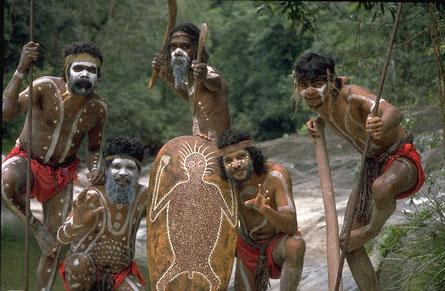Scholars have long been fascinated by the idea that something like the primordial or original religion existed until recently and may in fact be curated by a few people even today. If such “religions” could be identified, scholars hoped they could sketch the historical development or genealogy of religions. For old-time cultural evolutionists this amounted to a progression from “primitive” to “civilized” religion, and for present-day evolutionary theists it is a progression from misguided animism to “true” religion. Early anthropologists (Edward Burnett Tylor) and sociologists (Emile Durkheim) believed that primordial “religion” could be found among native, aboriginal, or tribal peoples.
During the late 1800s and early 1900s, the supposed exemplar of such religion came from the Australian Aborigines, and in the 1970s the south African Bushmen or San were added as exemplars. In addition to these two allegedly primordial paradigms, many viewed native American peoples as bearers of ancient supernatural traditions. Others thought that isolated Amazonian and Melanesian societies could shed light on the subject.
What many of these reconstruction projects have in common is the assumption that all such peoples were frozen in time and that their “religions,” which are not isomorphic with Western concepts and definitions of “religion,” did not change over time. We know, of course, that none of this correct — all such peoples have complex histories of migration, contact, and change. While some may have carried on in ways that more closely resembled ancient lifeways, this doesn’t mean their “religions” (a word and concept foreign to most or all of them) are static models of the Paleolithic past. At best, they can serve as rough analogues that may have more in common with ancient ideas than do modern or “world religions.” At worst, they are considered to be pristine exemplars of original religion.
While it might seem that anthropologists are aware of these issues, duly cautious, and provide the requisite qualifications, reminders are occasionally needed. One such reminder came in 1989 with the publication of Edwin Wilmsen’s Land of the Flies: A Political Economy of the Kalahari, which ignited a major and acrimonious debate about the history of south African Bushmen. Wilmsen argued, with some ideological zeal, that the San were not pristine hunter-gatherers but instead were marginalized peoples who became foragers only recently and as a result of larger economic processes. For all the book’s faults, Wilmsen demonstrated that the Bushmen had a more complex history than was supposed and were not pristine exemplars of the ancient past.
Similar kinds of debates have surrounded Australian Aborigines, whose “religion” known as “the Dreaming” has long been the darling of scholars. Durkheim’s famous Elementary Forms of the Religious Life (1912) relied on a sketchy construction of Aboriginal supernaturalism. While this construction was brought up to date by Mircea Eliade’s studies on “Australian Religions,” Eliade’s phenomenological commitments were distorting. Knowing this, several scholars have continued with the reconstruction or recovery process. While I haven’t followed the details, in 2009 whatever was happening prompted Max Charlesworth to issue some reminders:
Again, the radically ahistorical approach that Radcliffe-Brown introduced into anthropology de-emphasized cultural and religious change and development, and made it appear that Aboriginal societies and their religions were wholly static, conservative and ‘timeless’. However, in actual fact there is continual change and innovation in Aboriginal religions with sacred songs and rituals being exchanged and bartered between regional groups within the bounds of the foundation charters of the Dreamings of particular groups. Indeed, the various Dreamings have themselves often undergone change and innovation.
[I]n actual fact the Dreaming myths of many Aboriginal peoples have creatively assimilated elements from other groups. The most striking example of this is the influence of Muslim fishermen in Macassar in Indonesia on the Yolngu people of Elcho Island in northeast Arnhem Land. The Macassans were engaged in the collection of trepang and they came down with the trade winds each year from the early 1700s until 1907, establishing close economic and social relations with the Aboriginal people. As a result of this contact, an important Yolngu ritual about a Dreaming figure Walitha ‘walitha (in other words, Allah) was developed.
Here we have history impinging on our idealistic notions about what Aboriginal “religion” represents. In addition, there are problems of secrecy and translation:
Finally, a note about the role of secrecy in Aboriginal religions. For Western anthropologists observing the canons of scientific rationalism, there can be no ‘secrets’ since anthropologists are committed to public disclosure of their findings. However, for Aboriginal groups there are secrets not only between men and women but also between old and young, the initiated and non-initiated, and insiders and outsiders. Religious knowledge is ‘dangerous’ if it is divulged to the wrong people at the wrong time. [F]rom this point of view, the very attempt to investigate Aboriginal religion necessarily puts a public construction upon something that is essentially non-public.
The same is true of translating Aboriginal religious concepts into Western European terms. For example, the Ancestor Spirits are neither gods nor moral exemplars and one cannot use monotheistic language about them. In fact, the specific terrains, lands or ‘countries’ of the various Aboriginal groups are the crucial religious phenomena. As it has been put, Aboriginal religions are ‘geosophical’ and not theosophical.
To make a long, partial, and always changing story short, we must take our constructions of other traditions with several grains of cautionary salt.

References:
Charlesworth, Max. (2009). Anthropological Approaches to “Primitive” Religions Sophia, 48 (2), 119-125 DOI: 10.1007/s11841-009-0096-5
Eliade, Mircea. (1966). Australian Religions: An Introduction. Part I History of Religions, 6 (2) DOI: 10.1086/462538


